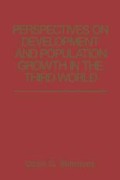Abstract
As indicated in Chapter 1, scholars in the fields of population and of development largely went their separate ways until relatively recently, with few attempts to bring together the two fields. This divergence was reflected in the scant attention paid to population variables in economic and social development planning and in the relatively superficial concern with development issues in population studies. Until the mid-1970s, “population and development” served primarily as a slogan invoked at international conferences. Over the past decade, however, concern with the complex interrelationships between population and development has generated a voluminous literature, replete with controversy and rhetoric as well as scientific reports on systematic research and analysis.
Access this chapter
Tax calculation will be finalised at checkout
Purchases are for personal use only
Preview
Unable to display preview. Download preview PDF.
Notes
Caldweli (1976:323) maintains that modern demographic-transition theory was “born almost in mature form in a paper written by Notestein in 1945.”
The meaning of “fertility” in this discussion foll~ws customary demographic usage; namely, it refers to the rate, or frequency, at which women bear children. More specifically, the fertility rate (also called the general fertility rate) is the number of live births per 1000 women aged 15–44 years (in some countries, the age range used is 15–49) in a given year.
Although the demographic paradigm attributed mortality declines in Europe largely to death control, it should be noted that development-related factor s in addition to health and sanitation services contributed to these declines. Prominent among these factors were improved transportation and communication facilities, the shift from home- to factory-based employment, and the advent of scientific agriculture. Freedman (1979) has noted some of these factors, both in Europe and in such LDCs as China and Sri Lanka, as well as the state of Kerala in India, that motivated lower fertility in these places; they facilitated mortality declines as well.
This description of the stages of demographic-transition theory largely follows that of Teitelbaum (1975).
Author information
Authors and Affiliations
Rights and permissions
Copyright information
© 1988 Plenum Press, New York
About this chapter
Cite this chapter
Simmons, O.G. (1988). Links between Development Perspectives and Population Growth. In: Perspectives on Development and Population Growth in the Third World. Springer, Boston, MA. https://doi.org/10.1007/978-1-4684-5514-4_4
Download citation
DOI: https://doi.org/10.1007/978-1-4684-5514-4_4
Publisher Name: Springer, Boston, MA
Print ISBN: 978-1-4684-5516-8
Online ISBN: 978-1-4684-5514-4
eBook Packages: Springer Book Archive

